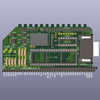

Amstrad CPC, RC2014, Z80, Raspberry Pi Pico, TTL processors and the occasional bit of Eurorack
This profile is from a federated server and may be incomplete. Browse more on the original instance.

Amstrad CPC, RC2014, Z80, Raspberry Pi Pico, TTL processors and the occasional bit of Eurorack
This profile is from a federated server and may be incomplete. Browse more on the original instance.